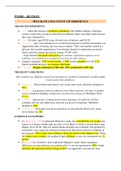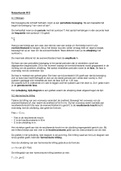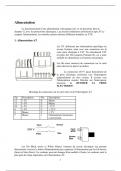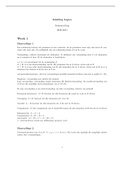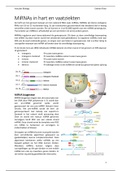Lecture 1: The Networked Organization Social Media @ Work
The changing nature of work
What was work like before 1700? Pre-modernity
• Mostly males
• Mostly agriculture
• Physical labor
• Central aim = producing ‘food’
• Small-scale, relatively localized production
• Based on individual skills and craftsmanship
What was work like between 1700-1960? Modernity (Industrial Revolution)
• Factory work (industry and manufacturing)
• Central aim = producing ‘goods’ to earn a wage that enables you to consume goods
• Large-scale, centralized production incorporating heavy, mechanized machinery
• Centralized, strong hierarchical managerial bureaucracies
• Based on mass numbers of wage workers
• Fixed locations
• Relatively easy for workers to organize themselves (unions)
What was work like between 1960-1990? Late modernity (Information Society wave 1)
• Office work - services industry (you need services of an advertising agency for selling your products)
• Central aim = producing ‘information’
• Knowledge and information get economic value
• Scattered production
• Functional differentiation: need for schooling to deliver ‘experts’
What does work look like nowadays? Late modernity (Information Society wave 2)
• Multitasking
• Freelancing (for multiple organizations in different projects)
• Work from home
• Self-development/ life balance
• Increasing digitization that makes previous methods of production obsolete (music, print press, postal
services).
So, work has changed. Social media helps us with all the characteristics of work now (multitasking etc.).
Social media changes everything, but the way we work is also developing social media. There is an interplay
between what we as organization want and what technology offers → structuration of technology.
As a result of these changes, relationship between people and society, the way how people function have
changed. The world is getting smaller.
What technological advances did we see in the way we work?
• Email (faster response, problem solving, work life balance, but also misinterpretation)
• Cloud (synchronous, place and time, easier to work). You can work at the same time and work in the
same document with Google Docs. Not limited to a fixed location or country. Makes it easier to work
independent of place and time.
• LinkedIn (job market, recruitment, show yourself). It has changed the job market en recruitment. Show
yourself online (positioning of yourself and self-presentation). In the 1960’s, you had to physically see
someone and know someone. Now. It is not necessary anymore with social media.
• Those technologies affect the way we work.
, Theory of modernity
Separation of space and time
• Time and space in pre-modern world (before 1700). Also time calculations (calendar), but time was always
connected to space (no when without where). Time was always imprecise and variable (different from
town to town).
• Time an space in 18th to 20th century. Mechanical clock and its diffusion worldwide. Precise designation
of ‘zones’ of time (parts of the day). Uniformisation of time can be understood as an ‘emptying’ of the
concept of time, as it is no longer bound to places and people, but exists as a ‘meta-system’.
• Important factor contributing to emptying space = mapping of the globe → uniform understanding of
geographical location and geographical form.
The emptying of space and time (two standardized dimensions), but recombinations:
• Example: schedule of train → a device that ‘orders’ time and space, thereby enabling a complex
coordination of trains and passengers and freight.
• Enables supply-chain processes
• Enables collaboration over the boarders
What we talked about now are theories of modernity about how society and structure within society
function. Those theorie try to describe different types of structures/organizations and how they may have
changed. They are called theories of modernity.
Giddens’ theory of modernity (1979)
Giddens’ theory of Modernity (Giddens, 1979).
There are three advances in society since past 50 years. People become less space-time dependent.
Before, we had systems and we trusted that systems. Now, we don’t have that social systems anymore.
Instead of trusting our local community, we trust money, the government and institutions. We trust systems
instead of people. Theory is applicable to social media.
1. Reduction of space-time
• Communication across vast distances, regardless of time & synchronicity. You don’t have to be there at
the same time together.
• We can work from home, from everywhere, freelancing.
• Easier to travel.
• Easier to cross through different times
• Time was always connected to space (no when without where) and was always imprecise and
variable from town to town.
• Uniformisation of time = an ‘emptying’ of the concept of time, as it is no longer bound to places and
people, but exists as a ‘meta-system’
• Also for spaces: an important factor contributing to emptying space = mapping of the globe.
Uniform understanding of geographical location and geographical form. And example is schedule of
trial which enables time and space.
2. Dis-embedding of social systems (the things that we are used to are not bound to a specific place of
time, e.g. money)
Example of freelancers. Before we had like fixed systems. You live in the village, if you have a problem
you go to the mare. You trusted people you knew. Now, we don’t really have those social systems
anymore. If I want to sell you something, then I see I don’t even know you and I don’t trust you. Instead
of trusting our local community we have to trust in institutions (money, government, nation). We trust
systems instead of people. Freelance work; you don’t work for a fixed organization. You’re not longer
part of the system of a organization.
• Systems independent of locality.
• Trust in sites and tokens.
• E.g. social media: go beyond the systems we are in. No longer meet a physical store to do our
shopping. So continuing new systems.
,3. Increased reflexivity (we also value reason more and more)
Means that we rely less on the things we assume are true but rely more and more on reason and things
we come up with ourselves. We don’t trust the police in the village, but we trust ourselves and what we
google ourselves.
• Reason over tradition.
• Reliance on knowledge. It does not also mean that we can go beyond the boundaries we used to, to
gather additional knowledge (e.g., not fixed to a certain location to go to University).
4. Information technology revolution
• Consumption spreads faster today.
Information Technology Revolution
The ICT revolution already started in 1960-1970, but is especially the case since the advent (komst) of the
internet and mobile communication (1990).
Increase in the speed of technological change. Newer technologies (tv, microwave) ism much steeper and
smartphone really really steep.
1. Machine replace brainpower
We could basically do everything without communication and information technology, it only becomes
much harder. Course management costs a lot of time by hand, now we use Canvas, etc.
• From remembering data to creativity & knowledge creation (i.e., databases, search engines, decision
support, machine learning, AI). It isn’t simply remembering something but also spelling errors. Decision-
support system: Google (is this what you meant?). it predicts what you mean.
• AI, planning tools, answering machine.
2. Pervasiveness of IT
We use our smartphones everywhere and we lose physical reality. IT is really everywhere. Few of use
make physical notes on paper.
• ‘I forgot my phone’, Charlene de Guzman.
• We have gone far in the adoption of use of laptops in classrooms etc. First was the question if students
were allowed to use a laptop in class at all.
3. Convergence of technology
Different technologies become one. A mobile phone basically is a lot of different technologies in one.
Allows us to do a lot of things with one technology.
• Communication across vast distances, regardless of time & synchronicity.
4. Network logic
If you look at social media applications, most allow you to link certain things to each other. Link people,
link knowledge. Connect people, et cetera.
• Interconnectedness of machines, people, organizations, etc.
• By means of IT (i.e., also social media)
Networked Individualism / Networked Enterprise
1. Early industrialized society (1900): people bound up in groups or ‘Little boxes’.
If you look how organizations are structured, you see it increasingly becomes networked. Three phases in
society and three phases in organizations and he divines them according to their network logic. Little boxes
represent how people worked, but also how organizations functioned a few years ago. Organizations were
little boxes. People had a single well-defined job, usually for life or long period of time. They worked on a
clearly defined tasks, people worked together physically in a certain space in a certain time.
• A few groups with clear boundaries.
• Hierarchically and structured.
• Social activity bounded by place and time.
• Dominant mode of communication: face-to-face (door-to-door)
Then he said if you look at organizations at the end of 20th century, you see that organizations are glocalized;
becomes more and more a network but those physical spaces that we use to define as an organization
become less and less important. People start to work in different project groups, modern communication
technologies (phone, e-mail, internet).
, People could increasingly connect with each other, besides of the information they had in their own space.
Organizations work together, economy globalized. More and more a network. More based on interests of
people. If you are interested in south America butterflies for example; there is a community. You can organize
yourself according to what you find interesting.
Parallel to Castells’ development of the concept of a Network Society, Barry Wellman, a well-known
Canadian sociologist, has developed similar ideas about how society is changing, and how this is affecting
the life of everyday people. Wellman focuses more on the individual, rather than on ‘macro-level’ entities
(Castells is interested in power structures, government, financial institutions, … - Wellman more in the
everyday experiences).
Few groups with clear boundaries:
- Kinship (family by bloodtie/marriage)
- Local work (farming, trades, shopkeepers)
- Physical neighbourhood
- Community life (e.g., church)
These groups often have boundaries for inclusion and structured, hierarchical, organization: supervisors and
employees, parents and children, pastors and churchgoers, organizational executives and members. In such
a society, each social interaction has its place: one group at a time. No role diffusion. High in social control:
people know who you are and in what groups you are. A lot of ‘groupware’ (computer software & hardware
aimed at group collaboration) focuses on facilitating these “little boxes” – co-workers who work in a group
with clear boundaries, and who all have a joint task.
2. Glocalized networks (1960-2000)
• People in different places and multiple social networks.
• ‘Psychological neighborhoods’: communities based on common interest.
• Social networks disembedded from ‘place’. However, place remains important as the home and work
place are the bases = place-to-place connectivity. Still tied to a place. More interconnections, but still
also organized in different groups.
• Dominant mode of communication: fixed telephone, mail, fax and (by the end of 20th century) Internet
(email).
• Still little boxes, but now increasingly connected compared the industrialized society.
• Organize yourself by interest.
• E.g. Studying in Tilburg, living in Nijmegen, work in Amsterdam. Your life is still organized quite locally,
but it is really connected.
This shift has been afforded both by social changes – such as liberalized divorce laws – and technological
changes – such as the proliferation of expressways and affordable air transportation. People usually obtain
support, companionship, information and a sense of belonging from those who do not live within the same
neighborhood or even within the same metropolitan area. Many people’s work involves contact with shifting
sets of people in other units, workplaces, and even other organizations. People maintain these ties through
phoning, emailing, writing, driving, railroading, transiting, and flying. The Internet both provides a ramp onto
the global information highway and strengthens local links within neighborhoods and households.
3. Networked individualism (21st century, emerging)
What society will become is more and more individualized. More connected, but also more individuals within
that network. Less bound to certain communities. Only part for a certain amount of time. So a network is not
like boxes anymore. Everyone is connected, but individual. No longer organized in fixed communities, but we
rely on ourselves and own network for everything we do. Little boxes are too extreme and will never happen.
• Person-to-person connectivity.
• Rapid switching between networks.
• Each person separately operates his network to obtain information, collaboration, orders, support,
sociability, and a sense of belonging.
• Interpersonal relationships increasingly based on specialized (narrow) roles (specialized social
networks), own set of skills.
• Weak ties become increasingly important. Your network becomes larger.
The changing nature of work
What was work like before 1700? Pre-modernity
• Mostly males
• Mostly agriculture
• Physical labor
• Central aim = producing ‘food’
• Small-scale, relatively localized production
• Based on individual skills and craftsmanship
What was work like between 1700-1960? Modernity (Industrial Revolution)
• Factory work (industry and manufacturing)
• Central aim = producing ‘goods’ to earn a wage that enables you to consume goods
• Large-scale, centralized production incorporating heavy, mechanized machinery
• Centralized, strong hierarchical managerial bureaucracies
• Based on mass numbers of wage workers
• Fixed locations
• Relatively easy for workers to organize themselves (unions)
What was work like between 1960-1990? Late modernity (Information Society wave 1)
• Office work - services industry (you need services of an advertising agency for selling your products)
• Central aim = producing ‘information’
• Knowledge and information get economic value
• Scattered production
• Functional differentiation: need for schooling to deliver ‘experts’
What does work look like nowadays? Late modernity (Information Society wave 2)
• Multitasking
• Freelancing (for multiple organizations in different projects)
• Work from home
• Self-development/ life balance
• Increasing digitization that makes previous methods of production obsolete (music, print press, postal
services).
So, work has changed. Social media helps us with all the characteristics of work now (multitasking etc.).
Social media changes everything, but the way we work is also developing social media. There is an interplay
between what we as organization want and what technology offers → structuration of technology.
As a result of these changes, relationship between people and society, the way how people function have
changed. The world is getting smaller.
What technological advances did we see in the way we work?
• Email (faster response, problem solving, work life balance, but also misinterpretation)
• Cloud (synchronous, place and time, easier to work). You can work at the same time and work in the
same document with Google Docs. Not limited to a fixed location or country. Makes it easier to work
independent of place and time.
• LinkedIn (job market, recruitment, show yourself). It has changed the job market en recruitment. Show
yourself online (positioning of yourself and self-presentation). In the 1960’s, you had to physically see
someone and know someone. Now. It is not necessary anymore with social media.
• Those technologies affect the way we work.
, Theory of modernity
Separation of space and time
• Time and space in pre-modern world (before 1700). Also time calculations (calendar), but time was always
connected to space (no when without where). Time was always imprecise and variable (different from
town to town).
• Time an space in 18th to 20th century. Mechanical clock and its diffusion worldwide. Precise designation
of ‘zones’ of time (parts of the day). Uniformisation of time can be understood as an ‘emptying’ of the
concept of time, as it is no longer bound to places and people, but exists as a ‘meta-system’.
• Important factor contributing to emptying space = mapping of the globe → uniform understanding of
geographical location and geographical form.
The emptying of space and time (two standardized dimensions), but recombinations:
• Example: schedule of train → a device that ‘orders’ time and space, thereby enabling a complex
coordination of trains and passengers and freight.
• Enables supply-chain processes
• Enables collaboration over the boarders
What we talked about now are theories of modernity about how society and structure within society
function. Those theorie try to describe different types of structures/organizations and how they may have
changed. They are called theories of modernity.
Giddens’ theory of modernity (1979)
Giddens’ theory of Modernity (Giddens, 1979).
There are three advances in society since past 50 years. People become less space-time dependent.
Before, we had systems and we trusted that systems. Now, we don’t have that social systems anymore.
Instead of trusting our local community, we trust money, the government and institutions. We trust systems
instead of people. Theory is applicable to social media.
1. Reduction of space-time
• Communication across vast distances, regardless of time & synchronicity. You don’t have to be there at
the same time together.
• We can work from home, from everywhere, freelancing.
• Easier to travel.
• Easier to cross through different times
• Time was always connected to space (no when without where) and was always imprecise and
variable from town to town.
• Uniformisation of time = an ‘emptying’ of the concept of time, as it is no longer bound to places and
people, but exists as a ‘meta-system’
• Also for spaces: an important factor contributing to emptying space = mapping of the globe.
Uniform understanding of geographical location and geographical form. And example is schedule of
trial which enables time and space.
2. Dis-embedding of social systems (the things that we are used to are not bound to a specific place of
time, e.g. money)
Example of freelancers. Before we had like fixed systems. You live in the village, if you have a problem
you go to the mare. You trusted people you knew. Now, we don’t really have those social systems
anymore. If I want to sell you something, then I see I don’t even know you and I don’t trust you. Instead
of trusting our local community we have to trust in institutions (money, government, nation). We trust
systems instead of people. Freelance work; you don’t work for a fixed organization. You’re not longer
part of the system of a organization.
• Systems independent of locality.
• Trust in sites and tokens.
• E.g. social media: go beyond the systems we are in. No longer meet a physical store to do our
shopping. So continuing new systems.
,3. Increased reflexivity (we also value reason more and more)
Means that we rely less on the things we assume are true but rely more and more on reason and things
we come up with ourselves. We don’t trust the police in the village, but we trust ourselves and what we
google ourselves.
• Reason over tradition.
• Reliance on knowledge. It does not also mean that we can go beyond the boundaries we used to, to
gather additional knowledge (e.g., not fixed to a certain location to go to University).
4. Information technology revolution
• Consumption spreads faster today.
Information Technology Revolution
The ICT revolution already started in 1960-1970, but is especially the case since the advent (komst) of the
internet and mobile communication (1990).
Increase in the speed of technological change. Newer technologies (tv, microwave) ism much steeper and
smartphone really really steep.
1. Machine replace brainpower
We could basically do everything without communication and information technology, it only becomes
much harder. Course management costs a lot of time by hand, now we use Canvas, etc.
• From remembering data to creativity & knowledge creation (i.e., databases, search engines, decision
support, machine learning, AI). It isn’t simply remembering something but also spelling errors. Decision-
support system: Google (is this what you meant?). it predicts what you mean.
• AI, planning tools, answering machine.
2. Pervasiveness of IT
We use our smartphones everywhere and we lose physical reality. IT is really everywhere. Few of use
make physical notes on paper.
• ‘I forgot my phone’, Charlene de Guzman.
• We have gone far in the adoption of use of laptops in classrooms etc. First was the question if students
were allowed to use a laptop in class at all.
3. Convergence of technology
Different technologies become one. A mobile phone basically is a lot of different technologies in one.
Allows us to do a lot of things with one technology.
• Communication across vast distances, regardless of time & synchronicity.
4. Network logic
If you look at social media applications, most allow you to link certain things to each other. Link people,
link knowledge. Connect people, et cetera.
• Interconnectedness of machines, people, organizations, etc.
• By means of IT (i.e., also social media)
Networked Individualism / Networked Enterprise
1. Early industrialized society (1900): people bound up in groups or ‘Little boxes’.
If you look how organizations are structured, you see it increasingly becomes networked. Three phases in
society and three phases in organizations and he divines them according to their network logic. Little boxes
represent how people worked, but also how organizations functioned a few years ago. Organizations were
little boxes. People had a single well-defined job, usually for life or long period of time. They worked on a
clearly defined tasks, people worked together physically in a certain space in a certain time.
• A few groups with clear boundaries.
• Hierarchically and structured.
• Social activity bounded by place and time.
• Dominant mode of communication: face-to-face (door-to-door)
Then he said if you look at organizations at the end of 20th century, you see that organizations are glocalized;
becomes more and more a network but those physical spaces that we use to define as an organization
become less and less important. People start to work in different project groups, modern communication
technologies (phone, e-mail, internet).
, People could increasingly connect with each other, besides of the information they had in their own space.
Organizations work together, economy globalized. More and more a network. More based on interests of
people. If you are interested in south America butterflies for example; there is a community. You can organize
yourself according to what you find interesting.
Parallel to Castells’ development of the concept of a Network Society, Barry Wellman, a well-known
Canadian sociologist, has developed similar ideas about how society is changing, and how this is affecting
the life of everyday people. Wellman focuses more on the individual, rather than on ‘macro-level’ entities
(Castells is interested in power structures, government, financial institutions, … - Wellman more in the
everyday experiences).
Few groups with clear boundaries:
- Kinship (family by bloodtie/marriage)
- Local work (farming, trades, shopkeepers)
- Physical neighbourhood
- Community life (e.g., church)
These groups often have boundaries for inclusion and structured, hierarchical, organization: supervisors and
employees, parents and children, pastors and churchgoers, organizational executives and members. In such
a society, each social interaction has its place: one group at a time. No role diffusion. High in social control:
people know who you are and in what groups you are. A lot of ‘groupware’ (computer software & hardware
aimed at group collaboration) focuses on facilitating these “little boxes” – co-workers who work in a group
with clear boundaries, and who all have a joint task.
2. Glocalized networks (1960-2000)
• People in different places and multiple social networks.
• ‘Psychological neighborhoods’: communities based on common interest.
• Social networks disembedded from ‘place’. However, place remains important as the home and work
place are the bases = place-to-place connectivity. Still tied to a place. More interconnections, but still
also organized in different groups.
• Dominant mode of communication: fixed telephone, mail, fax and (by the end of 20th century) Internet
(email).
• Still little boxes, but now increasingly connected compared the industrialized society.
• Organize yourself by interest.
• E.g. Studying in Tilburg, living in Nijmegen, work in Amsterdam. Your life is still organized quite locally,
but it is really connected.
This shift has been afforded both by social changes – such as liberalized divorce laws – and technological
changes – such as the proliferation of expressways and affordable air transportation. People usually obtain
support, companionship, information and a sense of belonging from those who do not live within the same
neighborhood or even within the same metropolitan area. Many people’s work involves contact with shifting
sets of people in other units, workplaces, and even other organizations. People maintain these ties through
phoning, emailing, writing, driving, railroading, transiting, and flying. The Internet both provides a ramp onto
the global information highway and strengthens local links within neighborhoods and households.
3. Networked individualism (21st century, emerging)
What society will become is more and more individualized. More connected, but also more individuals within
that network. Less bound to certain communities. Only part for a certain amount of time. So a network is not
like boxes anymore. Everyone is connected, but individual. No longer organized in fixed communities, but we
rely on ourselves and own network for everything we do. Little boxes are too extreme and will never happen.
• Person-to-person connectivity.
• Rapid switching between networks.
• Each person separately operates his network to obtain information, collaboration, orders, support,
sociability, and a sense of belonging.
• Interpersonal relationships increasingly based on specialized (narrow) roles (specialized social
networks), own set of skills.
• Weak ties become increasingly important. Your network becomes larger.

